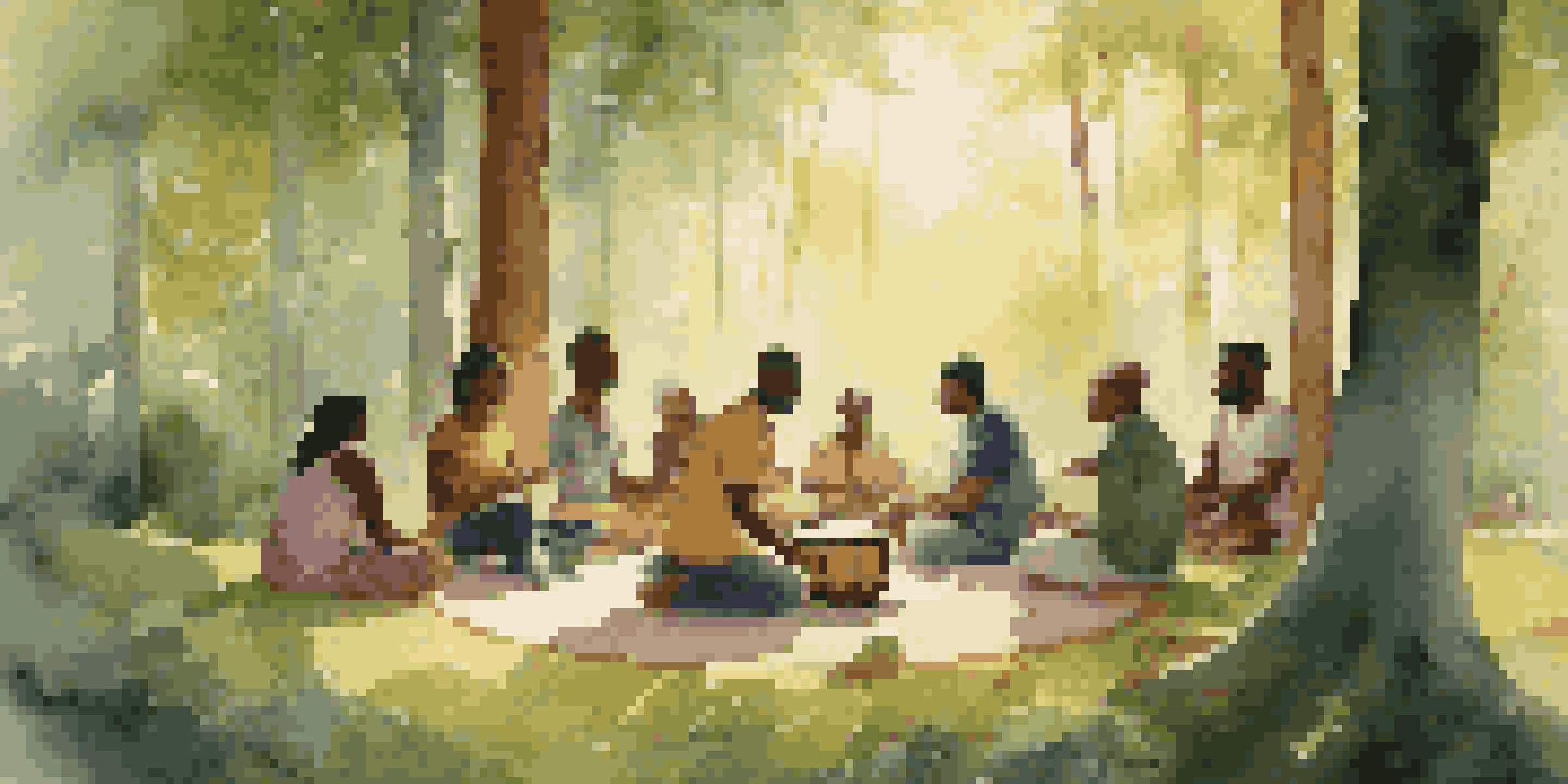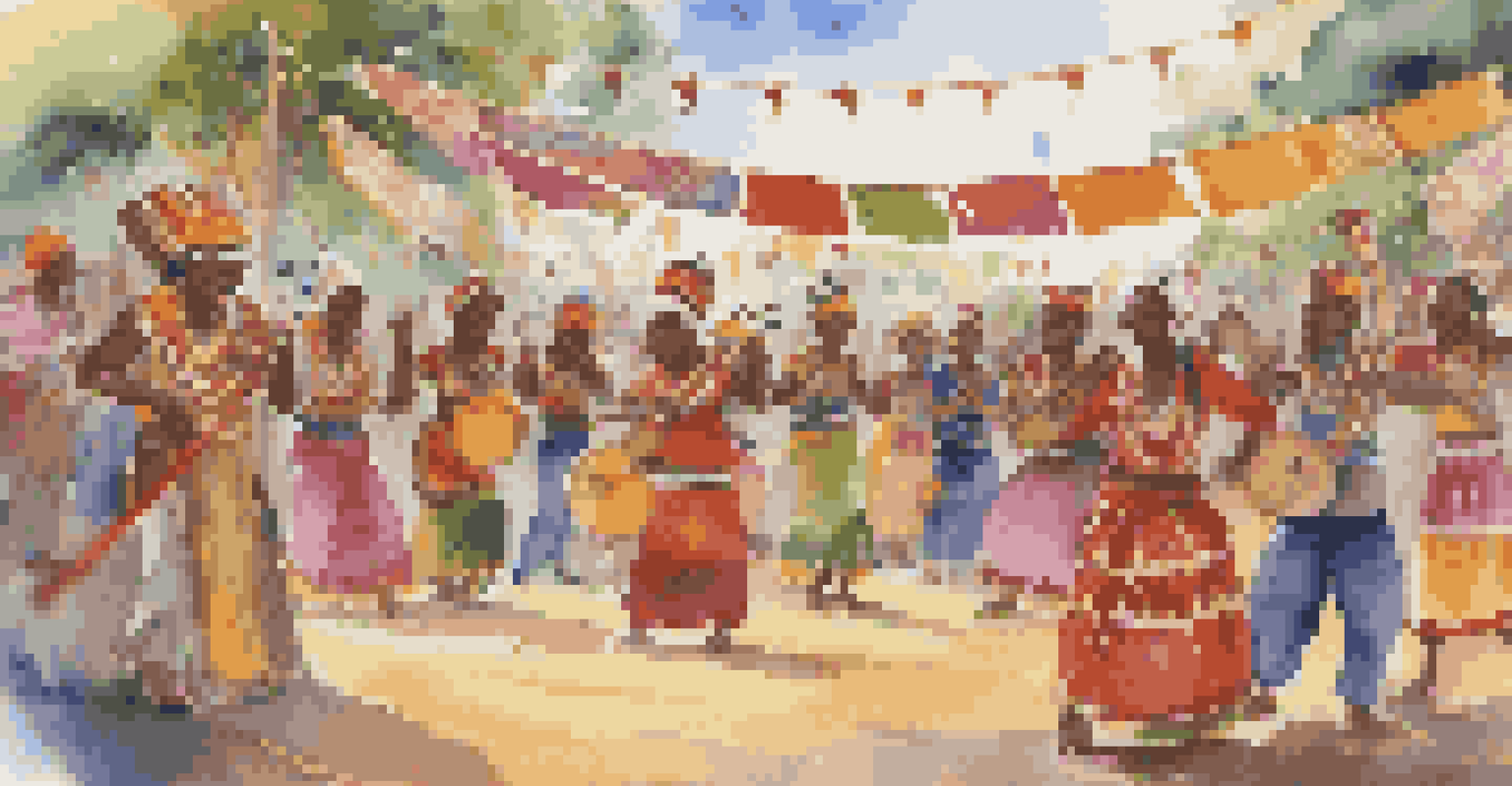The Healing Power of Music in Different Cultures

Understanding Music's Role in Healing
Music has been a part of human culture for centuries, serving not just as entertainment but also as a powerful healing tool. Various studies show that music can reduce stress, alleviate pain, and even enhance emotional well-being. This universal language connects people across different backgrounds, making it a vital aspect of healing practices globally.
Music can change the world because it can change people.
In many cultures, music is intertwined with rituals and ceremonies, often used to mark significant life events or transitions. For instance, indigenous cultures frequently employ drumming or chanting during healing ceremonies to foster a sense of community and connection. This communal aspect of music amplifies its healing effect, creating an environment of support and understanding.
Moreover, music therapy has gained recognition in modern medicine, where trained professionals use music to address physical, emotional, and cognitive issues. By harnessing the therapeutic properties of music, practitioners can tailor their approach to meet individual needs, showcasing the adaptability of music as a healing medium.
Traditional Healing Music in Indigenous Cultures
Indigenous cultures around the world have long recognized the healing power of music, incorporating it into their traditional medicine practices. For instance, Native American healing ceremonies often feature songs and chants that invoke spiritual guidance and foster healing energies. These musical elements are believed to create a sacred space for healing to occur.

In Africa, drumming is a central component of community gatherings and healing rituals. The rhythmic beats are not just for entertainment; they are thought to resonate with the body and spirit, promoting physical and emotional healing. This deep connection between rhythm and well-being reflects a profound understanding of music's impact on health.
Music as a Universal Healing Tool
Music serves as a powerful healing medium, reducing stress and enhancing emotional well-being across diverse cultures.
Similarly, in Aboriginal Australian culture, music is used to tell stories and pass down knowledge, often linked to healing practices. The Didgeridoo, for example, is not only an instrument but also a tool for healing, as its vibrations are believed to promote physical health and emotional balance.
The Influence of Music in Eastern Healing Practices
Eastern cultures have long embraced music as a healing art, with practices like traditional Chinese medicine integrating sound therapy into their approach. For instance, the concept of Qi, or life energy, is believed to be influenced by sound, and specific musical notes correspond to different organs in the body. This intricate relationship underscores the holistic nature of healing in these traditions.
Where words fail, music speaks.
In India, the practice of Raaga, a melodic framework used in classical music, is thought to evoke specific emotions and, in turn, promote healing. Each Raaga is associated with particular times of day and seasons, emphasizing the connection between music, nature, and human experience. This tailored approach to music showcases its potential for emotional and psychological healing.
Furthermore, sound baths, popular in various Eastern wellness practices, use harmonious sounds to promote relaxation and healing. Participants immerse themselves in soothing tones from instruments like singing bowls, which are believed to facilitate deep relaxation and rejuvenation, illustrating music's profound impact on mental and physical well-being.
Western Music Therapy and Its Benefits
In the Western world, music therapy has emerged as a recognized and effective form of treatment for various conditions. Professional music therapists use musical interventions to address emotional, cognitive, and social needs, helping individuals navigate challenges like trauma, depression, and anxiety. This therapeutic approach highlights the versatility and effectiveness of music in promoting healing.
Research supports the efficacy of music therapy, showing that it can enhance mood, improve communication skills, and even reduce feelings of pain. For example, patients undergoing surgery often report lower anxiety levels when music is played in the recovery room. This evidence reinforces the idea that music can serve as a powerful adjunct to traditional medical treatments.
Cultural Variations in Music Healing
Different cultures utilize music in unique ways for healing, reflecting their traditions and community values.
Additionally, music therapy is increasingly being integrated into rehabilitation programs for individuals recovering from strokes or brain injuries. By engaging patients in musical activities, therapists can stimulate brain function and improve motor skills, demonstrating how music can be a catalyst for physical recovery and cognitive rehabilitation.
Music and Emotional Well-Being
Music has an incredible ability to influence our emotions, making it a valuable tool for enhancing emotional well-being. People often turn to music during challenging times, using it to express feelings that words alone cannot convey. This emotional connection can provide comfort and validation, making music an essential part of coping strategies.
For instance, listening to uplifting songs can boost mood and increase feelings of happiness, while slower, more reflective music can facilitate emotional release during times of sadness. This duality illustrates how music can serve as both a source of joy and a means of processing pain, allowing individuals to navigate their emotional landscapes.
Moreover, group music-making activities, like singing in a choir or participating in drumming circles, foster a sense of belonging and community. These shared experiences can alleviate feelings of isolation and loneliness, reinforcing the idea that music can be a powerful connector in the healing process.
Cultural Variations in Music Healing Practices
While the healing power of music is universal, its applications vary widely across cultures. In Japan, for example, the practice of Shinrin-yoku, or forest bathing, incorporates music and soundscapes to enhance the therapeutic benefits of nature. This unique blend of music and nature exemplifies a holistic approach to well-being.
Conversely, in the Caribbean, Calypso music is often used in healing rituals, where the rhythms and lyrics reflect the community's experiences and struggles. This culturally specific use of music highlights how local traditions shape the ways communities understand and utilize music for healing.
Future Innovations in Music Therapy
Advancements in technology and ongoing research are paving the way for new applications of music therapy in healthcare.
These cultural variations remind us that while music is a common thread in healing practices, the specific methods and meanings can differ significantly. By appreciating these diverse approaches, we can gain a richer understanding of music's role in promoting health and well-being across the globe.
The Future of Music in Healing Practices
As our understanding of the healing power of music continues to evolve, new frontiers in music therapy are emerging. Advances in technology, such as virtual reality and AI-driven music experiences, are being explored to enhance therapeutic applications. These innovations may offer exciting new ways to harness music's healing potential.
Moreover, ongoing research is crucial in validating and expanding the scope of music therapy. By studying its effects on various health conditions, we can develop more effective treatment plans that integrate music into conventional healthcare. This evidence-based approach will help bridge the gap between traditional practices and modern medicine.

Lastly, as we recognize the importance of mental health, the role of music as a therapeutic tool will likely gain even more prominence. Communities may increasingly embrace musical activities as a means of fostering well-being, showcasing music's timeless ability to heal and unite us all.